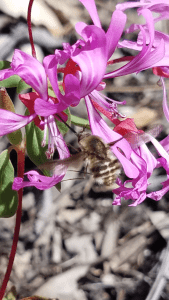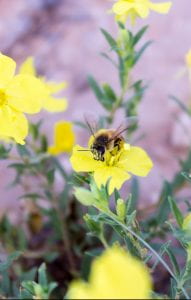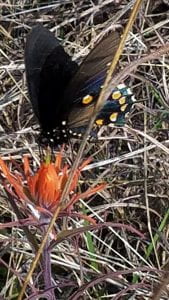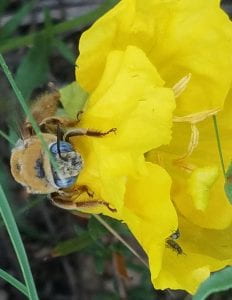Pollination
One of the few things that is as fascinating as the diversity of flowers, is the diversity of animals that pollinate them.
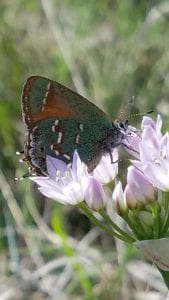
Pollination: Like many others, I am fascinated with animal pollination of flowers. My main interest is how these different pollinators move pollen around and how this can affect genetic diversity. When we measure the effectiveness of different pollinator guilds we can do it in many ways, including maternal fitness (number of seed sired), paternal fitness (number of fathers) and match choice ( Distance pollen travels within and between populations).
My lab’s research is focused on:
- Pollen dispersal distances. Pollinator behaviour and movement can have an important impact on gene-flow distances. This can be beneficial in dispersing diversity but can potentially constrain local adaptation.
- Current Members: Andrew Davies (PhD), Dylan Cohen (Postdoc)
- Past Members: Matt Rhodes (MS 2014 – with KS), Emily Lewis (MS 2015 – KS), Claire Ellwanger (MS 2016)
- Potential drivers that lead to changes in pollinator preference. When a population differs in their preferred pollinator, this can have important consequences for the evolutionary trajectory of the species
- Current Members: Emma Fetterly (MS, Co-advised with Andrea Kramer)
- Past Members: Anita Cisternas-Fuentes (PhD,2020) Katie Wenzell (PhD, 2021), Anna Braum (MS 2013), Laney Widener (MS 2014) Eun Sun Kim (University of Illinois, Chicago, Ph.D., 2019)
- Pollinator community changes and their implications for plant reproductive fitness.
- Current Members: Brendan Connolley (Co-advised with Paul Cara Donna),
- Past Members: Kelly Ksiazek (MS 2012, Ph.D. 2017 with KS) and Rebecca Tonietto (MS 2009, Ph.D. 2015 with Dan Larkin)
Media
- NPR Radio on Dimensions Work
- Mate limitation – Video from CPC (Rafael)
Publications (± = Postdoc, + = PhD Student, ++ = MA Student, * = Undergraduate Student, # =Citizen Scientist)
- Diaz-Martin Z±, A Cisternas-Fuentes, KM Kay, RA Raguso, K Skogen, JB Fant (2023) Reproductive strategies and their consequences for divergence, gene flow, and genetic diversity in three taxa of Clarkia. Heredity 131 (5), 338-349
- Wenzell, Katherine E. +, Krissa A. Skogen, and J.B. Fant. 2023. “Range-Wide Floral Trait Variation Reflects Shifts in Pollinator Assemblages, Consistent with Pollinator-Mediated Divergence despite Generalized Visitation.” Oikos, no. December 2022: 1–18. https://doi.org/10.1111/oik.09708.
- Lewis EM, JB Fant, MJ Moore, KA Skogen (2023) Hawkmoth and bee pollinators impact pollen dispersal at the landscape but not local scales in two species of Oenothera. American Journal of Botany, e16155
- Cisternas‐Fuentes A., T Jogesh, GT Broadhead, RA Raguso, KA Skogen, JB Fant (2022) Evolution of selfing syndrome and its influence on genetic diversity and inbreeding: A range‐wide study in Oenothera primiveris. American Journal of Botany 109 (5), 789-805
- Wenzell, K. E. +, McDonnell, A. J., Wickett, N. J., Fant, J. B., & Skogen, K. A. (2021). Incomplete reproductive isolation and low genetic differentiation despite floral divergence across varying geographic scales in Castilleja. American Journal of Botany, 108(7), 1–19. https://doi.org/10.1002/ajb2.1700
- Kim, E. S. +, Zaya, D. N., Fant, J. B., & Ashley, M. V. (2019). Reproductive trade-offs maintain bract color polymorphism in Scarlet Indian paintbrush (Castilleja coccinea). PloS One, 11–14. https://doi.org/10.13012/B2IDB-0852856
- Ksiazek-Mikenas, K. +, Fant, J. B., & Skogen, K. A. (2019). Pollinator-Mediated Gene Flow Connects Green Roof Populations Across the Urban Matrix: A Paternity Analysis of the Self-Compatible Forb Penstemon hirsutus. Frontiers in Ecology and Evolution, 7(August), 299. https://doi.org/10.3389/fevo.2019.00299
- Skogen, K. A., Overson, R. P., Hilpman, E. T., & Fant, J. B. (2019). HAWKMOTH POLLINATION FACILITATES LONG-DISTANCE POLLEN DISPERSAL AND REDUCES ISOLATION ACROSS A GRADIENT OF LAND-USE. Annals of the Missouri Botanical GardenMissouri Bptanic Garden, 104(Fall), 495–511. https://doi.org/10.3417/2019475
- Widener, L. ++, & J.B. Fant (2018) Genetic differentiation and diversity of two sympatric subspecies of Castilleja affinis; a comparison between the endangered serpentine endemic (spp. neglecta) and its widespread congener (ssp. affinis) Conserv Genet 19 (2) 365-381
- Rhodes, Matthew K. ++, J. B. Fant, Krissa A. Skogen (2017) Pollinator identity and spatial isolation influence multiple paternity in an annual plant. Molecular Ecology 26 (16) 4296–4308
- Skogen, K. A., T. Jogesh, E. T. Hilpman*, S. L. Todd*, M. K. Rhodes*, S. Still, and J. B. Fant. (2016) Land-use change has no detectable effect on reproduction in a disturbance-adapted plant pollinated by long-distance dispersing hawkmoths. American Journal of Botany. 103:1950-1963
- Ksiazek, K., J. B. Fant and K. Skogen. (2012) An assessment of pollen limitation on Chicago green roofs. Landscape and Urban Planning. 107 (4) 401-408
- Kramer, A.T., J.B. Fant and M. Ashley (2011) Influences of landscape and pollinators on population genetic structure: Examples from three Penstemon (Plantaginaceae) species in the Great Basin. American Journal of Botany 98(1): 109–121.
- Ksiazek, K., J. Fant and K. Skogen. 2011. An assessment of pollination services on Chicago green roofs. In Proceedings of the CitiesAlive! Ninth Annual Green Roof and Wall Conference. Philadelphia, PA, 2011. Toronto: Green Roofs for Healthy Cities.
- Tonietto R, J. Fant, J Ascher, K. Ellis and D Larkin (2011) A comparison of bee communities of Chicago green roofs, parks and prairies. Landscape and Urban Planning 103: 102– 108
- Kramer, A.T.+ and J.B. Fant. (2007) Isolation and characterization of microsatellite loci in Penstemon rostriflorus (Plantaginaceae) and cross species amplification. Molecular Ecology Notes 7 (6), 998–1001.
